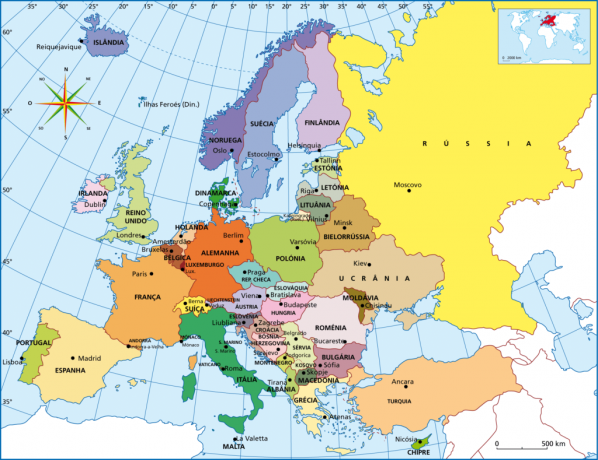THE plasma membrane is a cell envelope formed by a semipermeable lipid bilayer that controls the entry and exit of substances from the cell through active transport, which expend energy, and passive transport, without energy expenditure.
We prepare a list of exercises on active and passive transport so you can test your knowledge of membrane transports.
You can consult the template and save this exercise list in PDF at the end of the post!
Exercises on active and passive transport
1) (CFTMG) The plasma membrane delimits the cell, allowing the selective passage of substances from the external to the internal environment and vice versa. If these substances are transported with expenditure of energy, then the mechanism involved is (o):
a) gas exchange.
b) active transport.
c) simple diffusion.
d) facilitated diffusion.
2) (UFPA) A plant cell placed in a hypotonic medium:
a) will undergo plasmolysis.
b) will not undergo any change.
c) will become turgid.
d) will undergo plasmolysis.
e) there will be water leaving the cell.
3) (UFSC) The plasma membrane is a semi-permeable membrane, and there are usually no conditions for the extravasation of cytoplasmic colloids outside the cell. In this regard, the membrane already begins to select what should enter the cell or leave it. Considering the different processes of passage through the plasma membrane, it is correct to state that:
01) osmosis is the passage of water molecules always in the direction of the more concentrated medium to the less concentrated one.
02) pinocytosis is another type of endocytosis, in which case there is an agglomeration of small amounts of liquid substances.
04) in active transport, enzymes act as carriers of molecules, such as sugar or ions.
08) phagocytosis is a type of endocytosis, where solid particles are engulfed.
16) in facilitated diffusion, special lipid molecules participate and energy is wasted.
32) for exocytosis, useless substances for the cell are eliminated with the help of centrioles.
4) (UFSM) A boy in love with fish decided to set up an aquarium in his house. In a store, he acquired three different species, taking into account the visual aspect: clownfish (Amphiprion ocellaris, marine species), emperor angelfish (pomacanthus imperator, marine species) and goldfish (Carassius auratus, freshwater species). All species were placed in the same aquarium, which was filled with dechlorinated tap water. Both marine species swelled and died quickly, and only the goldfish survived. After what happened, the boy discovered that the individuals of the two marine species died, because the aquarium water worked as a _______________ solution in relation to your body fluids, and a _______________ has caused the swelling by _______________.
Check the alternative that correctly completes the gaps in the text:
a) hypotonic - osmotic imbalance - excessive water absorption
b) hypotonic – active transport of minerals out of their bodies – excessive water absorption
c) hypertonic - osmotic imbalance - loss of mineral salts and dehydration of species
d) hypertonic – active transport of minerals into their bodies – excessive water absorption
e) isotonic - osmotic imbalance - loss of mineral salts and dehydration of species
5) Glucose is a substance that cannot freely penetrate the plasma membrane. For its transport to take place inside the cell, the help of proteins called permeases is essential. This type of transport is called:
a) osmosis.
b) simple diffusion.
c) sodium and potassium pump.
d) facilitated diffusion.
- Free Online Inclusive Education Course
- Free Online Toy Library and Learning Course
- Free Online Math Games Course in Early Childhood Education
- Free Online Pedagogical Cultural Workshops Course
6) (UEVA) The plasma membrane is a selective lipoprotein complex, which enables different concentrations and ionic exchanges between the intra and extracellular media. It is correct to say:
a) fat solubility and concentration gradient are factors inherent to passive transport.
b) in simple diffusion, the larger the solute molecule, the faster its transport across the membrane.
c) the solute concentration determines the osmotic phenomenon due to the greater permeability of the membrane.
d) in simple diffusion, the rate of transport across the membrane corresponds to the same rate compared to facilitated diffusion.
7) (UFPA) Under certain conditions, a plant cell can suffer the phenomenon of plasmolysis. This is because:
a) in a hypotonic medium, the cell loses water.
b) in a hypertonic medium, the cell absorbs water.
c) in a hypotonic medium, the cell absorbs water.
d) in a hypertonic medium, the cell loses water.
e) in isotonic medium, the cell loses electrolytes.
8) (PUC MG) A plant cell, plasmolysed in a weakly concentrated solution, was placed in another solution hypertonic in relation to the cell. As a result, the following should occur:
a) loss of water by the cell.
b) water gain by the cell.
c) balance from the start.
d) cell disruption.
e) solute output.
9) The transport of Na+ and K+ across the plasma membrane, with energy expenditure, is characterized as:
a) active transport.
b) passive transport.
c) facilitated diffusion.
d) simple diffusion.
e) osmosis.
10) The concentration of Na+ ions in the extracellular environment is higher than in the intracellular environment. The opposite is observed in the K+ ion concentration, as illustrated below. This concentration difference is maintained by active transport. However, there is also displacement of these ions from the place where they are in greater concentration to the place of less concentration, by a process of:
a) clasmocytosis.
b) phagocytosis.
c) osmosis.
d) diffusion.
e) pinocytosis.
Template
1 - b
2 - c
3 - 02, 04 and 08
4 - the
5 - d
6 - the
7 - d
8 - the
9 - the
10 - d
Click here to save this exercise list to PDF!
See too:
- List of exercises on Brazilian biomes
- List of exercises on the water cycle
- List of exercises on vitamins
The password has been sent to your email.

